英语-倒装句用法精编版
倒装句的用法与例句
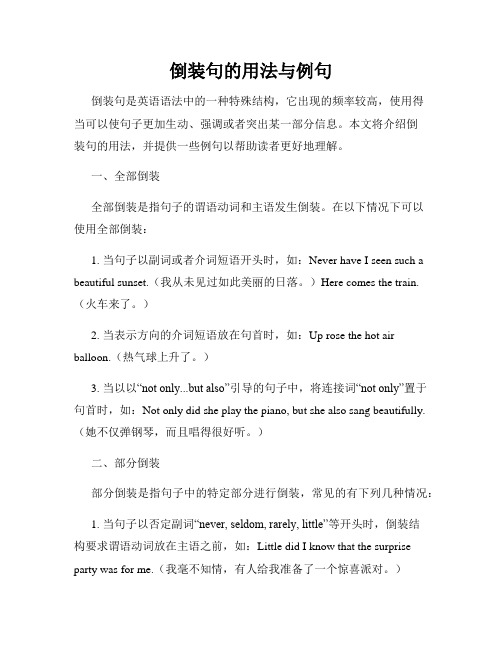
倒装句的用法与例句倒装句是英语语法中的一种特殊结构,它出现的频率较高,使用得当可以使句子更加生动、强调或者突出某一部分信息。
本文将介绍倒装句的用法,并提供一些例句以帮助读者更好地理解。
一、全部倒装全部倒装是指句子的谓语动词和主语发生倒装。
在以下情况下可以使用全部倒装:1. 当句子以副词或者介词短语开头时,如:Never have I seen such a beautiful sunset.(我从未见过如此美丽的日落。
)Here comes the train.(火车来了。
)2. 当表示方向的介词短语放在句首时,如:Up rose the hot air balloon.(热气球上升了。
)3. 当以以“not only...but also”引导的句子中,将连接词“not only”置于句首时,如:Not only did she play the piano, but she also sang beautifully.(她不仅弹钢琴,而且唱得很好听。
)二、部分倒装部分倒装是指句子中的特定部分进行倒装,常见的有下列几种情况:1. 当句子以否定副词“never, seldom, rarely, little”等开头时,倒装结构要求谓语动词放在主语之前,如:Little did I know that the surprise party was for me.(我毫不知情,有人给我准备了一个惊喜派对。
)2. 当句子以表示条件的副词或者介词短语开头时,也可以使用倒装,如:Should you need any assistance, please feel free to ask.(如果你需要任何帮助,请随时提问。
)In case of emergency, break the glass.(紧急情况下,打破玻璃。
)3. 当句子中有“so/such...that”结构时,可以使用倒装结构,如:She was so tired that not only could she not finish her homework, but she alsofell asleep in class.(她太累以至于不仅没有完成她的家庭作业,还在课堂上睡着了。
英语 倒装句讲解精编版
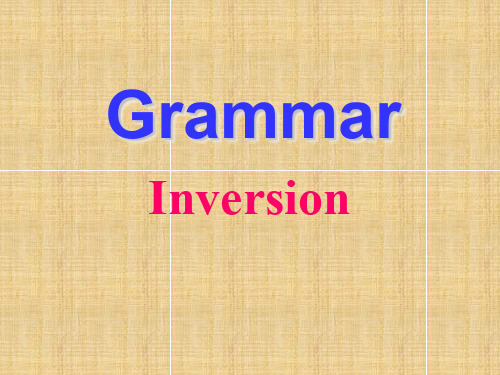
9. 如果直接引语后注明引语是什么人所 说的, 主语是名词时, 用倒装结构。主 语是代词时, 一般不用倒装结构。 “ Let’ go,” said the man / he said.
10. 用于 某些祝愿的句子。
May you succeed.
部分倒装:NAOSHI 1 No(never,not,neither,nothing,nowhere,no longer) 2 Seldom(little,few,rarely,scarcely,hardly) 3 否定词组by no means,in no case,in no way,at no time,in no sense,on no account,under no circumstances,on no account 4 否定句型not only/not until/no sooner…than/hardly….when
由 If you had reviewed your lessons 这样一个虚拟条件分句变过来的。
3. 用于“形容词(或名词、动词)+ as (though)” 引导的让步状语从句。 Pretty as she is, she is not clever. Try as he would, he might fail again. Money as they had, they don’t know how to spend it.
Not until the child fell asleep did the mother leave the room. 当Not until引出主从复合句,主句 倒装,从句不倒装。
5. 用于 never, hardly, seldom, scarcely, little, at no time, not only, barely, rarely, little, not a bit,no 等否定词开 头的句子里。
(完整版)倒装句的讲解
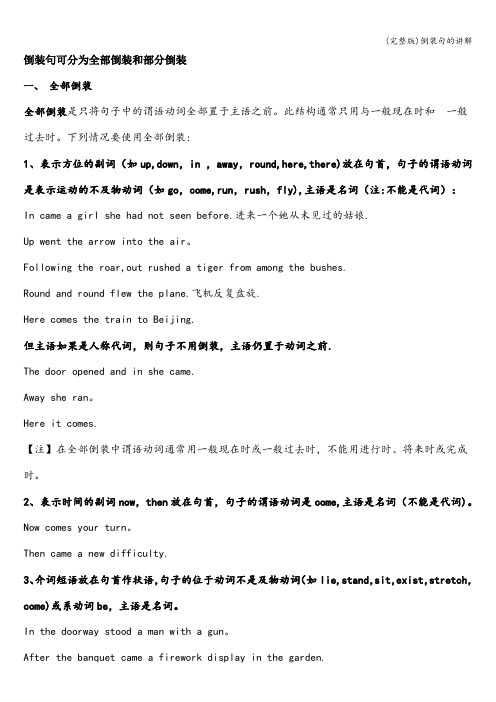
倒装句可分为全部倒装和部分倒装一、全部倒装全部倒装是只将句子中的谓语动词全部置于主语之前。
此结构通常只用与一般现在时和一般过去时。
下列情况要使用全部倒装:1、表示方位的副词(如up,down,in ,away,round,here,there)放在句首,句子的谓语动词是表示运动的不及物动词(如go,come,run,rush,fly),主语是名词(注:不能是代词):In came a girl she had not seen before.进来一个她从未见过的姑娘.Up went the arrow into the air。
Following the roar,out rushed a tiger from among the bushes.Round and round flew the plane.飞机反复盘旋.Here comes the train to Beijing.但主语如果是人称代词,则句子不用倒装,主语仍置于动词之前.The door opened and in she came.Away she ran。
Here it comes.【注】在全部倒装中谓语动词通常用一般现在时或一般过去时,不能用进行时、将来时或完成时。
2、表示时间的副词now,then放在句首,句子的谓语动词是come,主语是名词(不能是代词)。
Now comes your turn。
Then came a new difficulty.3、介词短语放在句首作状语,句子的位于动词不是及物动词(如lie,stand,sit,exist,stretch,come)或系动词be,主语是名词。
In the doorway stood a man with a gun。
After the banquet came a firework display in the garden.On the moon, as is known to all,exists no living thing。
英语倒装句12种类型及例句
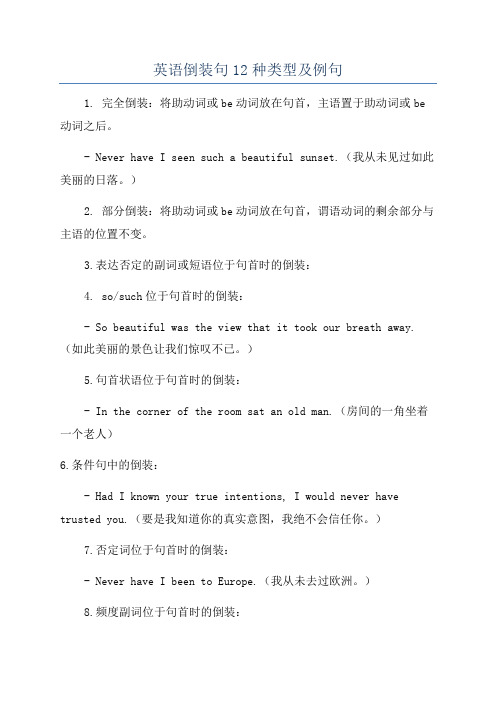
英语倒装句12种类型及例句1. 完全倒装:将助动词或be动词放在句首,主语置于助动词或be 动词之后。
- Never have I seen such a beautiful sunset.(我从未见过如此美丽的日落。
)2. 部分倒装:将助动词或be动词放在句首,谓语动词的剩余部分与主语的位置不变。
3.表达否定的副词或短语位于句首时的倒装:4. so/such位于句首时的倒装:- So beautiful was the view that it took our breath away.(如此美丽的景色让我们惊叹不已。
)5.句首状语位于句首时的倒装:- In the corner of the room sat an old man.(房间的一角坐着一个老人)6.条件句中的倒装:- Had I known your true intentions, I would never have trusted you.(要是我知道你的真实意图,我绝不会信任你。
)7.否定词位于句首时的倒装:- Never have I been to Europe.(我从未去过欧洲。
)8.频度副词位于句首时的倒装:- Rarely do we see such dedication.(我们很少见到如此的奉献精神。
)9.祈使句或祈使句部分的倒装:- Stand up!(站起来!)- Be quiet, please.(请安静。
)10. only位于句首时的倒装:- Only by working hard can you achieve your goals.(只有通过努力工作,你才能实现目标。
)11.地点状语置于句首时的倒装:- In the garden were beautiful flowers.(花园里有美丽的花朵。
)12.宾语置于句首时的倒装:- A love like this I have never felt before.(我之前从未感受过如此的爱。
(完整版)初中英语倒装句简单版
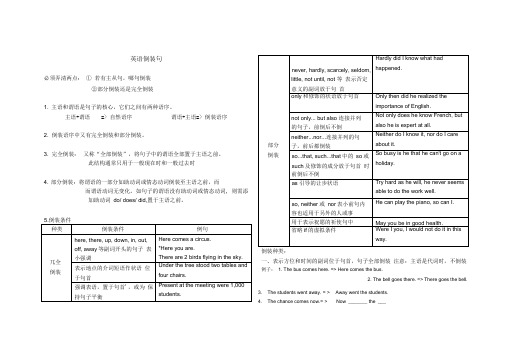
英语倒装句必须弄清两点:① 若有主从句,哪句倒装②部分倒装还是完全倒装1. 主语和谓语是句子的核心,它们之间有两种语序。
主语+谓语=> 自然语序谓语+主语=> 倒装语序2. 倒装语序中又有完全倒装和部分倒装。
3. 完全倒装:又称“全部倒装”,将句子中的谓语全部置于主语之前。
此结构通常只用于一般现在时和一般过去时4. 部分倒装:将谓语的一部分如助动词或情态动词倒装至主语之前,而而谓语动词无变化。
如句子的谓语没有助动词或情态动词, 则需添加助动词do/ does/ did,置于主语之前。
倒装种类:一、表示方位和时间的副词位于句首,句子全部倒装注意:主语是代词时,不倒装例子:1. The bus comes here. => Here comes the bus.2. The bell goes there. => There goes the bell.3. The students went away. = > Away went the students.4. The chance comes now.= > Now _______ the ___5. He rushed out. => Out __ .6. He comes here. => There二、以介词短语表示的状语,提前位于句首,全部倒装。
例子1. A tower stands in front of our school.=> In front of our school stands a tower.2. A temple stands at the top of the mountain.=> the top of mountain stands .3. Christmas trees, flowers and toys are among the goods.=> the goods Christmas trees, flowers and toys.三、表语位于句首,倒装结构表语+系动词+主语A. 形容词+系动词+主语Professor White and many other guests were present at the meeting.=> Present at the meeting were Professor White and many other guests.B. 过去分词+系动词+主语The days when they could do are gone.=> Gone are the days when they could do.四、将so/ neither/ nor放在开头,表示"••也(不)…",部分倒装注意:表示确实是这样”不倒装1. He went to the film last night. So did I.2. You must finish your work, so I.3. She is interested in the story, so I.4. He didn ' turn up. Neither his brother.*5. His mother told him not to go to the film. So he did.五、在if条件句,通常可以省略if,而将从句倒装条件:在if条件句,必须含有系动词were,助动词had情态动词should1. If he were younger, he would learn skating.Were he younger, he would learn skating.2. If they should forget to bring a map with them, they would get lost in the woods. they forgetto bring a map with them, they would get lost in woods.3. If they had realize how important the task was, they wouldn ' have refused to accept.=> they how important the task was, they wouldn ' have refused to accept.4. If I were you, I would help her.=> I you, I would help her.六、否定词或半否定词位于句首,部分倒装never/ little/ seldom/ not/ nowhere/ scarcely/ few/by no means(决不)/ at no time(从不)1. I have never been there. => Never have I been there.2. I knew little about it. => Little did I know about it.3. She seldom came late to school =>did she late to school.4. You should buy that kind of car by no means.should you that kind of car.七、以not until/ no sooner ••- than(一••就)/hardly ••- when(刚…就)/所引导的状语放在句首,部分倒装1. She didn't realize that she had lost her necklace until she got home.She realized that she had lost her necklace when she got home.=> Not until she got home did she realize that she had lost her necklace.直到她到了家才发现她丢了项链。
(完整word版)初中常用的倒装句

常用的倒装句文/杨学军郭晓伟一、全倒装句1、在there be 句型中(be还可换成live,lie等表示状态的动词,要用全倒装。
There are a lot of people in the hall.大厅里有很多人。
Long ,long ago ,there lived a king .很久,很久以前,有一位国王。
2、以there,here, now,then 等引起的句子中,谓语动词常为be,come,go 等,要用全倒装。
Here are some picture-books.这儿是一些连环图画。
Now comes your turn.现在该抡到你了。
如果主语是人称代词这不用倒装:Here they are .他们在这儿。
3、某些表示祝愿的句子用全倒装:Long live China!中国万岁!May your country become stronger.祝贵国更强大。
4、so(such)...that 结构中,so或such位于句首加强语气时,用全倒装:So angry was he that he couldn’t speak.他如此愤怒,以致说不出话来。
5、在in,out,aways,off,up,down 等副词开头的句中,为了使情景更生动,用全倒装:Up went the arrow into the air.嗖地一声,箭射上了天。
注:主语是代词时,则不用倒装:Away they went.他们走了。
6、整个(或部分)直接引语置于名词充当的主语前时,用全倒装:“They must be in the fields now.”thought Mr Li.“他们准是下地了,“李先生想。
注:主语是人称代词时,多不用倒装:“What do you want?”he asked.“你要什么?”他问。
7、为保持句子平衡,或使上下文衔接更紧,可把介词短语、形容词、副词或分词提到句首,引起全倒装:On the ground lay an old sick goat,which had gone into the cave to die.地上躺着一只有病的老山羊,它是到洞里去等死的。
英语倒装句用法经典总结

英语倒装句用法经典总结1.完全倒装句:主语和谓语动词完全倒置。
如:- Never have I seen such a beautiful sunset.(我从未见过如此美丽的日落。
)- Little did he know about the problem.(他对问题一无所知。
)2.部分倒装句:只将助动词或情态动词和主语进行倒置。
如:- Can you swim?(你会游泳吗?)- Should you have any questions, please let me know.(如果你有任何问题,请告诉我。
)3.如果句子以表示地点的副词或介词短语开头,也需要进行倒装。
如:- On the top of the mountain stood a small cabin.(在山顶上有一间小木屋。
)4.如果句子以表示否定意义的副词或介词短语开头,也需要进行倒装。
如:- Under no circumstances will I allow that to happen.(无论如何,我都绝不容许那种事情发生。
5. 在条件句中,如果主语和谓语动词之间使用“had”,“were”或“should”时,需要进行倒装。
如:- Had I known it earlier, I would have prepared better.(要是早知道这个,我会准备得更好。
)- Were I you, I would apologize.(要是我是你,我会道歉。
)以上是英语倒装句的几种常见用法,不同的倒装句用法可以根据具体的语境和语法规则进行灵活运用。
英语倒装句讲解精编版

( A) a man stood with black hair ( B ) had a man with black hair ( C) stood a man with black hair ( D ) were a man with black hair
2)引用动词另有宾语时,即使主语是名词 也不倒装。 “Why didn’t you join us!” Our monitor asked us.
7、谓语是be, 表语提前时,整 个句子需倒装。
Happy is he who devoted himself to the cause of communism.
2)当这些词作形容词修饰主语时且置句首 时,句子不倒装。 Little work was done yesterday.
5.Neither..nor连接的两个句子都要倒装; not only…but also连接的两个句子时, not only后面的句子要倒装, but also不倒装
1)Neither has he called on her, nor will he do so. 2)Not only shall we learn from books,
注意: only修饰状语从句时,主句中倒装,从 句中不倒装; only修饰的不是状语时,则不用倒装 语序。
Only the teachers can come in.
only +
Prep. phrase 时间副词
When--clause +助动词+主语+谓语
他只有昨天动身去东京。
Only yesterday did he leave for Tokyo.
(完整版)倒装

全部倒装全部倒装是指将句子中的谓语动词全部置于主语之前。
此结构通常只用与一般现在时和一般过去时。
常见的结构有:1. here, there, now, then, thus等副词置于句首, 谓语动词常用be, come, go, lie, run.例如: 1) There goes the bell。
铃声渐渐消失了.2) Then came the chairman. 然后主席就来了3) Here is your letter。
这是你的信.2. 表示运动方向的副词或地点状语置于句首,谓语表示运动的动词.例如:1) Out rushed a missile from under the bomber. 轰炸机下面发出了一颗导弹.2) Ahead sat an old woman。
注意:上述全部倒装的句型结构的主语必须是名词,如果主语是人称代词则不能完全倒装.例如:1) Here he comes。
他来了。
2) Away they went. 他们走了。
二部分倒装部分倒装是指将谓语的一部分如助动词或情态倒装至主语之前。
如果句中的谓语没有助动词或情态动词,则需添加助动词do, does或did,并将其置于主语之前。
1。
句首为否定或半否定的词语,如no, not, never, seldom, little, hardly, at no time, in no way, not until…等。
例如:1) Never have I seen such a performance。
我从来没看过这样的表演.2) Nowhere will you find the answer to this question. 你在哪儿都不会找到这个问题的答案.3) Not until the child fell asleep did the mother leave the room。
注意:当Not until引出主从复合句,主句倒装,从句不倒装。
(完整word版)高中英语全部倒装(可编辑修改word版)

高中英语倒装02-全部倒装倒装句主要分为和。
第十三章倒装A. 完全倒装完全倒装是将谓语的全部放在主语之前,此结构通常只用于一般现在时和一般过去时两种。
On her left sat her husband. 她左边坐着她丈夫。
Here is the book you want. 你要的书在这儿。
Down went the small boat. 小船沉下去了。
A.常见的完全倒装结构1.there be 句型。
There is a mobile phone and some books on the desk. 桌上有一个手机和一些书。
There are thousands of people gathering on the square. 广场上聚集着成千上万的人注意引导词there 还可以接appear, exist, lie, remain, seem, stand, live 等词。
There lived an old fisherman in the village. 村里住着一位老渔夫。
There stand two white houses by the river. 河滨矗立着两座白房子。
There existed some doubt among the students. 学生中有些怀疑。
2.用于here, there, now, thus, then + 动词+ 主语的句型中(谓语动词多为be, go, come 等)。
Here comes the bus.汽车来了。
There goes the bell. 铃响了。
Now comes my turn. 轮到我了。
Then came the order to take off. 起飞的命令到了。
3.以out, in, up, down, off, away 等副词开头,谓语动词是表示“移动”的go, come, leave 等句子里。
倒装句用法归纳整理

完全倒装&部分倒装一、完全倒装( 5items )1. 表示动作趋向的副词置于句首时且主语是名词,动词是表示运动或存现:Here/ There ;In / Out; Up/Down; Away + be/come/go/ rush/run + 主语Eg. Here comes the bus. There goes the bell.Up flew the balloon. Down fell the apples from the tree.Away went the angry manager. IncameMr. Wang.2. 时间副词 Now/ Then 置于句首,主语是名词,动词是趋向或存现动词go/come/be/rush/run 等Eg. Now comes your turn. Then starts another programme.3.地点介词作状语放在句首,主语是名词,动词表存现On top the mountain stands an old tree.At the foot of the hill lies a village.In front of the village runs a stream.4 .代词前置Such was Einstein, a great and cute man .5.表语前置(现在分词、过去分词、形容词)时实行完全倒装Walking beside me were some visitors from abroad.Gone are the days when the Chinese were looked down upon by foreigners. Attached to the meeting was a card.Present at the meeting were some leaders of the town.二、部分倒装( 10items )1. 否定词或半否定词置于句首,部分倒装Never/ Hardly/Seldom/ Little/Nowhere/ By no means … +助+主语Little does she care about what she looks.By no means will I forgive you.2. Not only+助+主谓 but also +主谓,前倒后不倒Not only had he sold out his house but he also sold his baby for drugs.3. Not until+主谓+助主谓,前不倒后倒Not until I began to work did I know how much I needed to learn.另外注意 It is not until …that…句型4. So /Neither/Nor 放在句首用部分倒装---He loves football. ---So do I.---He never swims. ----Neither/Nor does his girlfriend.5. Hardly/ No sooner had sb done when/ than sb did sth.Hardly had they arrived when it began to rain.6. So …that …/ Such …that 前倒后不倒So happy were the audiences that they laughed again and again. Such good weather is it that we feel like going outing.7. as/though 引导的让步状语从句( 4items )Child as he is, he manages to make a living by working in a factory.Strange as his idea might sound, it was a accepted at last.Hard as I tried, I couldn ’tpersuade her.Try as he might, he couldn ’t pass the exam.8. Only+状语(从句)置于句首,主句用倒装Only in this way can you improve your English.Only whenI became a mother myself did I know how tired my mother oncewas.9. 省略 if 的虚拟条件句中,将助动词 had/should/were 等提前,如果这些助动词跟有否定词 not, not 不提前If it hadn’t been for your timely help, I would still be in trouble now.= Had it not been for your timely help, I would still be in trouble now.10. 祝愿May you be happy !。
(完整版)英语倒装句详解
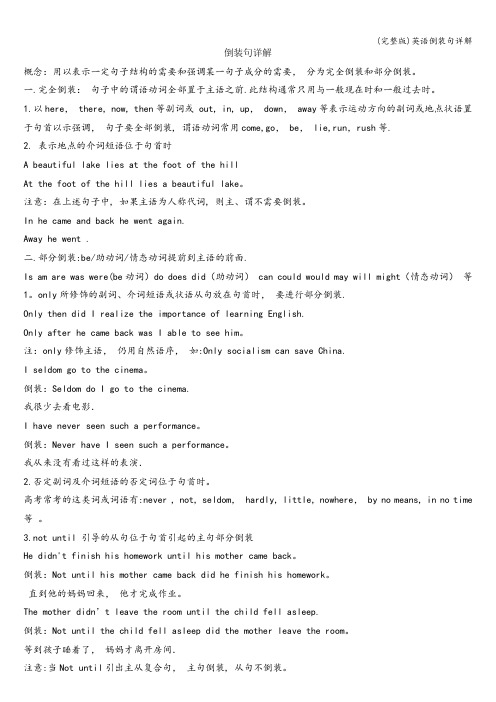
倒装句详解概念:用以表示一定句子结构的需要和强调某一句子成分的需要,分为完全倒装和部分倒装。
一.完全倒装:句子中的谓语动词全部置于主语之前.此结构通常只用与一般现在时和一般过去时。
1.以here, there, now, then等副词或 out, in, up, down, away等表示运动方向的副词或地点状语置于句首以示强调,句子要全部倒装, 谓语动词常用come,go, be, lie,run,rush等.2. 表示地点的介词短语位于句首时A beautiful lake lies at the foot of the hillAt the foot of the hill lies a beautiful lake。
注意:在上述句子中, 如果主语为人称代词, 则主、谓不需要倒装。
In he came and back he went again.Away he went .二.部分倒装:be/助动词/情态动词提前到主语的前面.Is am are was were(be动词)do does did(助动词) can could would may will might(情态动词)等1。
only所修饰的副词、介词短语或状语从句放在句首时,要进行部分倒装.Only then did I realize the importance of learning English.Only after he came back was I able to see him。
注:only修饰主语,仍用自然语序,如:Only socialism can save China.I seldom go to the cinema。
倒装:Seldom do I go to the cinema.我很少去看电影.I have never seen such a performance。
倒装:Never have I seen such a performance。
(完整word版)英语倒装句的用法归纳,推荐文档

英语部分倒装用法归纳1. 否定副词位于句首时的倒装在正式文体中,never, seldom, rarely, little, hardly, scarcely, no sooner, no longer, nowhere 等含有否定意义的副词若位于句首,则其后要用部分倒装:I shall never forgive him. / Never shall I forgive him. 我永远不会宽恕他。
He seldom goes out for dinner. / Seldom does he go out for dinner. 他很少出去吃饭。
She hardly has time to listen to music. / Hardly does she have time to listen to music. 她几乎没时间听音乐。
He little realizes how important this meeting is. / Little does he realize how important this meeting is. 他不甚明白这个会议的重要性。
We had no sooner reached the airport than the plane took off. / No sooner had we reached the airport than the plane took off. 我们刚到机场,飞机就起飞了。
【注意】(1) 对于not…until句型,当not until…位于句首时,其后的主句要用倒装语序:He didn’t leave the ro om until the rain stopped. / Not until the rain stopped did he leave the room. 雨停了之后他才离开这房间。
(2) 某些起副词作用的介词短语,由于含有否定词,若位于句首,其后要用部分倒装:On no accounts must this switch be touched. 这个开关是绝不能触摸的。
倒装句型 知识点讲解+精编练习

倒装句型知识点讲解+精编练习一、完全倒装:指谓语全部置于主语之前的倒装,有下列几种情况:1.单个副词here,there,away,in,out,down,up,off,back,now,then在句首时引起全部倒装表示强调,句子的谓语一般为be动词或不及物动词。
Eg: Here is a letter for you. There goes the last train.The door opened,and in came Mr Smith. Away went the boy.Down came the rain and up went the umbrellas. Back came the others.Out rushed the boy with an apple in his hand. Then came a noise like thunder.Now comes the bus.如果这类句子中的谓语动词是短语动词则不能将短语动词中的副词移到句首。
Eg. Up it blew.(错)____blew up: exploded*但有时也例外,当句子的主语在对比的情况下,作主语的人称代词也可与作谓语的be 动词形成倒装。
Eg. There were they, reading in the classroom, while we were cleaning outside.2.介词短语或方位名词词组作地点状语位于句首,引起全部倒装。
In the corner of the room stands a writing-table. South of the city lies a big factory.Under the bed lies a cat. In these oceans live huge numbers of a small fish .注:以上两种完全倒装谓语常用一般现在时或一般过去时,动词是表示方位或转移的不及物动词,如lie,live,sit,stand,be,come,go,rise,walk,run等,主语必须是名词,主语若是人称代词或谓语不属上述动词之列,则不用完全倒装。
倒装句的用法 归纳型的

倒装句的用法归纳型的1、倒装句的定义倒装句是一种将句子中的某些成分(如主语、谓语、宾语、状语等)的位置进行颠倒的句式,以达到强调、平衡句子结构或满足特定表达需要的目的。
11 完全倒装完全倒装是指将整个谓语动词置于主语之前。
111 表示地点、方位的副词或介词短语位于句首时,句子采用完全倒装。
例如:“Here comes the bus” (公共汽车来了。
)“In front of the house stands a tall tree” (房子前面有一棵大树。
)112 表示时间的副词位于句首时,句子采用完全倒装。
如:“Now comes your turn” (现在轮到你了。
)12 部分倒装部分倒装是指将助动词、情态动词或系动词置于主语之前。
121 否定副词或短语位于句首时,句子采用部分倒装。
常见的否定词有:never, seldom, hardly, little, not until 等。
例如:“Never have I seen such a beautiful place” (我从未见过如此美丽的地方。
)“Not until he came back di d I know the truth” (直到他回来我才知道真相。
)122 “so +助动词/情态动词/系动词+主语”表示前面所说的情况也适用于另一人或物。
如:“He likes music So do I” (他喜欢音乐,我也喜欢。
)123 “neither/nor +助动词/情态动词/系动词+主语”表示前面的否定情况也适用于另一人或物。
例如:“I don't like coffee Neither/Nor does she” (我不喜欢咖啡,她也不喜欢。
)124 only 位于句首修饰状语时,句子采用部分倒装。
例如:“Only in this way can you learn English well” (只有通过这种方式你才能学好英语。
倒装句的用法总结大全

倒装句的用法总结大全英语的倒装句是一个常考的知识点,它相对来说也比较难。
学好倒装句的用法对我们的写作有很大的帮助。
下面小编为你们分享倒装句的用法总结大全。
●完全倒装(无需助动词)(1) there,here,down,up,in,out,now,then,before,away,off等副词开头的句子,用来表示强调(主语为人称代词时不倒装);(2) 表示地点的介词短语作状语且位于句首时;(3) 表语置于句首,强调表语或保持句子平衡时.方法:(1)副词+谓语+主语,副词+主语+谓语(主语为代词时不倒装);(3) 介词短语+谓语+主语;(4) 形容词/ed分词/-ing分词/介词短语+be+主语.●部分倒装(需借助助动词)(1) only所修饰的副词/介词短语/状语从句位于句首时(但only修饰主语位于句首时不倒装);(2) never,hardly,seldom,scarcely,little,not…until,at no time,not once,not,no,in no time等否定意义的词位于句首时;(3) so…that中so或such…that中such位于句首时.方法:以上三种情况都倒装主句.(4) 形容词/名词/动名词+as/though的让步状语从句中(although引导的让步状语从句不能倒装,though也可以不倒装);方法:倒装从句.(5) not only…but also连接并列分句时(连接主语时不倒装);方法:前倒后不倒.(6) neither…nor连接并列分句时(连接主语时不倒装);方法:前后都倒.(7) so位于句首表示前句的内容也同样适用于后一个人或物时(只能是肯定句,且前后两句主语不同);方法:so+助动词+主语.(8) neither/nor用于句首,表示前句的否定内容也适用于后一句的人/物时(只能用于否定句,且前后两句主语不同);方法:neither/nor+助动词+主语.(9) 表示祝愿的祈使句中:方法:副词+谓语+主语,may+主语+谓语.(10)在虚拟语气中,如果if条件从句有系动词were或助动词should/had,可以把其置于句首,同时省去if.●典型考题(答案分别为BBA)1. So difficult _________ it to work out the problem that I decided to ask T om for advice.A. I did findB. did I findC. I have foundD. have I found2. _________ about wild plants that they decided to make a trip to Madagascar for further research.A. so curious the couple wasB. So curious were the coupleC. How curious the couple wereD. The couple was such curious3. —It’s burning hot today, isn’t it?—Yes. _________ yesterday.A. So was itB. So it wasC. So it isD. So is it特别说明:(1) 若前面提出某一否定的情况,要表示后者也属于同样的否定情况,则应将其中的so改为neither或nor。
英语倒装句讲解汇编

英语倒装句讲解倒装句分为全部倒装和部分倒装一.倒装句之全部倒装全部倒装是只将句子中的谓语动词全部置于主语之前。
此结构通常只用于一般现在时和一般过去时。
常见的结构有:1)here, there, now, then, thus等副词置于句首, 谓语动词常用be, come, go, lie, run等表示来去或状态的动词。
例如:Then came the chairman. 那时总裁来了。
Here is your letter. 你的信。
2)表示运动方向的副词或地点状语置于句首,谓语表示运动的动词。
例如:Out rushed a missile from under the bomber. 轰炸机肚底下窜出一枚导弹。
Ahead sat an old woman. 前面坐着一个老妪。
3) 在there be或者there live(stand, appear, seem, remain, exist….) 句型中。
例如:There are thousands of people on the square.There lived an old fisherman in the village.There stands a little girl.4)在某些表示祝愿的句型中。
例如:Long live the People's Republic of China! 中华人民共和国万岁!May you all be happy. 愿你们都快乐。
注意:上述全部倒装的句型结构的主语必须是名词,如果主语是人称代词则不能完全倒装。
例如:Here you are.Here he comes. 他来了。
Away they went. 他们走开了。
二.倒装句之部分倒装部分倒装是指将谓语的一部分如助动词或情态倒装至主语之前。
如果句子的谓语没有助动词或情态动词,则需添加助动词do, does或did,并将其置于主语之前。
英语倒装句的用法归纳汇编
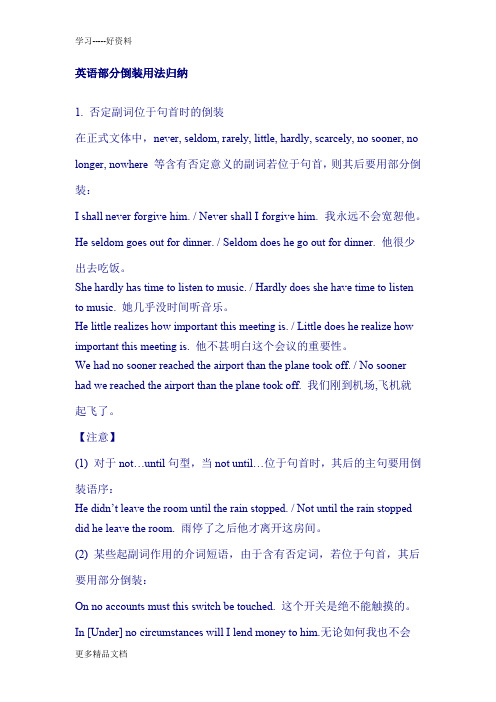
英语部分倒装用法归纳1. 否定副词位于句首时的倒装在正式文体中,never, seldom, rarely, little, hardly, scarcely, no sooner, no longer, nowhere 等含有否定意义的副词若位于句首,则其后要用部分倒装:I shall never forgive him. / Never shall I forgive him. 我永远不会宽恕他。
He seldom goes out for dinner. / Seldom does he go out for dinner. 他很少出去吃饭。
She hardly has time to listen to music. / Hardly does she have time to listen to music. 她几乎没时间听音乐。
He little realizes how important this meeting is. / Little does he realize how important this meeting is. 他不甚明白这个会议的重要性。
We had no sooner reached the airport than the plane took off. / No sooner had we reached the airport than the plane took off. 我们刚到机场,飞机就起飞了。
【注意】(1) 对于not…until句型,当not until…位于句首时,其后的主句要用倒装语序:He didn’t leave the ro om until the rain stopped. / Not until the rain stopped did he leave the room. 雨停了之后他才离开这房间。
(2) 某些起副词作用的介词短语,由于含有否定词,若位于句首,其后要用部分倒装:On no accounts must this switch be touched. 这个开关是绝不能触摸的。
- 1、下载文档前请自行甄别文档内容的完整性,平台不提供额外的编辑、内容补充、找答案等附加服务。
- 2、"仅部分预览"的文档,不可在线预览部分如存在完整性等问题,可反馈申请退款(可完整预览的文档不适用该条件!)。
- 3、如文档侵犯您的权益,请联系客服反馈,我们会尽快为您处理(人工客服工作时间:9:00-18:30)。
倒装句用法总结归纳
一、部分倒装:
1.否定副词位于句首时的倒装
在正式文体中,never, seldom, rarely, little, hardly, scarcely, no sooner, no longer, nowhere 等含有否定意义的副词若位于句首,则其后要用部分倒装:
I shall never forgive him. / Never shall I forgive him. 我永远不会宽恕他。
He seldom goes out for dinner. / Seldom does he go out for dinner. 他很少出去吃饭。
He little realizes how important this meeting is. / Little does he realize how important this meeting is. 他不甚明白这个会议的重要性。
注意:
(1) 对于not…until句型,当not until…位于句首时,其后的主句要用倒装语序:
He didn’t leave the room until the rain stopped. / Not until the rain stopped did he leave the room. 雨停了之后他才离开这房间。
(2) 某些起副词作用的介词短语,由于含有否定词,若位于句首,其后要用部分倒装:
On no accounts must this switch be touched. 这个开关是绝不能触摸的。
(3) 但是,in no time(立即,马上)位于句首时,其后无需用倒装语序:
In no time he worked out the problem. 他马上就算出了那道题。
2.“only+状语”位于句首时的倒装
当一个状语受副词only的修饰且置于句首时,其后用部分倒装语序:
Only then did he realize that he was wrong. 到那时他才意识到他错了。
Only in this way are you able to do it well. 你只有用这种方法才能把它做好。
3.“so+adj. / adv.”位于句首时的倒装
副词so后接形容词或副词位于句首时,其后用部分倒装:
So cold was the weather that we had to stay at home. 天气太冷,我们只好呆在家里。
So sudden was the attack that we had no time to escape. 袭击来得非常突然,我们来不及逃跑。
4.“so+助动词+主语”倒装
当要表示前面提出的某一肯定的情况也同样适合于后者,通常就要用“So+助动词+主语”这种倒装结构:
You are young and so am I. 你年轻,我也年轻。
If he can do it, so can I. 要是他能做此事,我也能。
注意:
(1) 若前面提出某一否定的情况,要表示后者也属于同样的否定情况,则应将其中的so改为neither或nor:
You aren’t young and neither am I. 你不年轻,我也不年轻。
She hasn’t read it and nor have I. 她没有读它,我也没有读。
(2) 注意该结构与表示强调或同意的“so+主语+特殊动词”结构的区别:
"It was cold yesterday." "So it was." “昨天很冷。
”“的确很冷。
”
"Father, you promised." "Well, so I did." “爸爸,你答应过的。
”“嗯,是答应过。
”
5. 由“not only…but also”引出的倒装
当not only…but also位于句首引出句子时,not only 后的句子通常用部分倒装形式:Not only is he a teacher, but he is also a poet. 他不仅是一位教师,而且是一位诗人。
Not only did he speak more correctly, but he spoke more easily. 不仅他讲得更正确,也讲得更不费劲了。
6. 虚拟条件句的省略与倒装
当if引导的虚拟条件从句中含有had, were, should等时,如将if省略,则要将had, were, should 等移到主语前,构成倒装句:
Had you come yesterday, you would have seen him.若你昨天来,你就会见到他了。
Should you require anything give me a ring. 如果需要什么,可以给我打电话。
Were it not for your help, I would still be homeless. 要不是你帮助,我会仍然无家可归。
注意:
省略if后提前的had不一定是助动词:
Had I money, I would buy it. 假若我有钱,我就会买它。
二、完全倒装:
1.here 和there位于句首时的倒装
表示地点的here和there位于句首时,其后用完全倒装形式。
这类倒装句的谓语通常是动词be和come, go等表示移动或动态的不及物动词:
Here’s Tom. 汤姆在这里。
Here comes the bus. 公共汽车来了。
There goes the last train. 最后一班火车开走了。
注意:
(1) 以上倒装句中的谓语动词come和go不能用进行时态,即不能说Here is coming the bus。
(2) 若主语为代词,则不倒装:
Here I am. 我在这儿。
/ 我来了。
Here it comes. 它来了。
(3) 其中的动词有时也可能是stand, lie, live等表示状态的动词(表示存在):
There stood a desk against the wall. 靠墙放着一张书桌。
Once upon a time there lived a man known by the name of Beef. 从前有个人名叫比夫。
2.away和down等位于句首时的倒装
地点副词away, down, in, off, out, over, round, up等位于句首时,其后用完全倒装语序。
这类倒装句的谓语通常表示动态的不及物动词:
Away went the runners. 赛跑选手们跑远了。
Round and round flew the plane. 飞机盘旋着。
The door opened and in came Mr Smith. 门开了,史密斯先生进了来。
注意:
若主语为人称代词,则不能用倒装:
Away he went. 他跑远了。
3.状语或表语位于句首时的倒装
为了保持句子平衡或使上下文衔接紧密,有时可将状语或表语置于句首,句中主语和谓语完全倒装:
Among these people was his friend Jim. 他的朋友吉姆就在这些人当中。
By the window sat a young man with a magazine in his hand. 窗户边坐着一个年轻人,手里拿着一本杂志。
注意:
在表语置于句首的这类倒装结构中,要注意其中的谓语应与其后的主语保持一致,而不是与位于句首的表语保持一致。
比较:
In the box was a cat. 箱子里是一只猫。
In the box were some cats. 箱子里是一些猫。
4. 分词和不定式置于句首的倒装
有时为了强调,可将谓语部分的现在分词、过去分词或不定式置于句首,从而构成倒装:Buried in the sands was an ancient village. 一个古老的村庄被埋在这沙土之中。
To be carefully considered are the following questions. 下列问题要仔细考虑。
